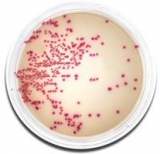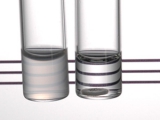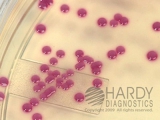Subscribe to our newsletter
HardyDisk™ Novobiocin Differentiation Disks are useful for presumptively distinguishing Staphylococcus saprophyticus from other coagulase-negative staphylococci in clinical specimens.
SUMMARY
Coagulase-negative staphylococci (CoNS) are among those organisms that have traditionally been considered skin contaminants, and their recovery from cultures doesn't always indicate presence of disease. Therefore, little attention had been paid to the pathogenic potential of this group of bacteria until recently. By the mid-1970's, microbiologists were becoming aware that CoNS could indeed be pathogenic, especially in compromised hosts. Today, S. saprophyticus has proven to be an important uropathogen. It is second only to E. coli as the most common cause of cystitis and acute urinary tract infection (UTI) in healthy, young adult women. S. saprophyticus tends to adhere to uroepithelial cells more often and more successfully than other staphylococcal species, this is believed to partially explain the organism's frequent role in urinary tract infections. The HardyDisk™ Novobiocin Differentiation Disks are useful in presumptively distinguishing S. saprophyticus from other CoNS. Other human staphylococcal species that are novobiocin-resistant (S. cohnii, S. xylosus, S. pulvereri) are rarely isolated from patients. The novobiocin susceptibility test can be done using a plate method (18-24 hour test) or a tube method (5 hour test). A study conducted by Harrington and Gaydos in 1984, concluded that the novobiocin tube test is an acceptable method when performed using Tryptic Soy Broth (TSB), 3ml, and has the advantage of taking only 5 hours.While the plate method is the more common approach of the two, both procedures are outlined in the section entitled "Procedure".
FORMULA
Each HardyDisk™ Novobiocin Differentiation Disk is prepared by impregnating 5ug of novobiocin onto high quality 6mm diameter filter paper disks.
PROCEDURE
Specimen Collection: This product is not intended for primary isolation of patient specimens. It should be used only with cultures of isolated organisms. This product is used in conjunction with other biochemical tests to identify cultures of isolated organism.
Plate Method:
1. Allow disks to equilibrate to room temperature.
2. Using a pure 18-24 hour culture, prepare a suspension, equivalent to a McFarland 0.5 opacity standard, in Tryptic Soy Broth (TSB, Cat. no. HDR30), Sterile Water (Cat. no. HDU85), or Brain Heart Infusion (BHI) Broth (Cat. no. HDR15).
3. Inoculate Mueller Hinton Agar (Cat. no. HDG45), Blood Agar, 5% (Cat. no. HDA10), or Tryptic Soy Agar (TSA, Cat. no. HDG60) plate with a sterile swab to obtain confluent growth.
4. Aseptically apply one novobiocin disk onto the inoculated agar surface and lightly press down to ensure full contact with the medium.
5. Incubate aerobically for 18-24 hours at 35-37 degrees C.6. Measure (in millimeters) the diameter of the zone of inhibition around the novobiocin disk, and record as susceptible or resistant. See section below, entitled "Interpretation of Results."
Tube Method:
1. Using a pure 18-24 hour culture, lightly inoculate two 3ml TSB tubes (Cat. no. R41) with the organism to be tested. The inoculum should be light, with no visible turbidity.
2. Immediately after inoculation, add one novobiocin disk to one of the tubes and shake for 5-10 seconds. The tube without the novobiocin disk will be the control tube.
3. Incubate both tubes aerobically at 35-37 degrees C. for up to 5 hours, or until the control tube (without novobiocin disk) shows turbidity comparable to that of a McFarland 0.5 opacity standard.
4. Check for turbidity in the tube containing the novobiocin disk as compared with the control tube, and record as susceptible or resistant. See section below, entitled "Interpretation of Results".
INTERPRETATION OF RESULTS
Plate Method:Sensitive - A zone of inhibition greater than 16mm.
Resistant - A zone of inhibition less than or equal to 16mm.
Cat. no. HDZ7291
Size: 50 disks/vial







 HardyCHROM MRSA
HardyCHROM MRSA Lysostaphin Differentiation Disks
Lysostaphin Differentiation Disks HardyCHROM Staph Aureus
HardyCHROM Staph Aureus